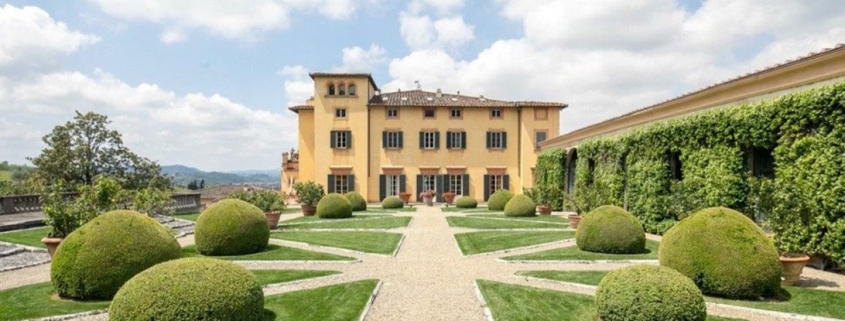Itinerary by car, motorcycle or bicycle – Orchards, villas and gardens
Orchards, villas and gardens: Bagno a Ripoli and the Medici Dynasty
Type of route: paved, practical for cars, motorcycles and bikes
Duration: ½ day
Level of difficulty: easy
Half-day itinerary by car, motorcycle or bicycle
The Bagno a Ripoli villa and gardens itinerary begins at the northern part of the city, near the banks of the Arno. It is here that one encounters, in Candeli, the Villa La Massa, now a luxury hotel. The beauty of the external areas of the villa lies mainly in its strategic position overlooking the curves of the Arno below. Lawns shaded by large trees and graveled areas beautified with flowers in clay pots surround the picturesque villa.
Villa La Massa: Via della Massa, 24
Tours by appointment – 055.626.11 – reservation@villalamassa.it
Leaving Via della Massa and crossing the Strada Provinciale #34, we will now take Via Molino di Villamagna. After just a few hundred meters we find the magnificent and imposing entrance gate of Villa la Tana. Beyond the gate you will notice a driveway lined by plants and further down a double staircase that leads to the villa. Here one also will see a nymphaeum decorated with sponges and shells. Behind the villa rests a garden made up of geometric parterres, fountains and an aviary.
Villa La Tana: Via Molino di Villamagna
To the east of the Villa La Tana, heading in the direction of the San Donnino a Villamagna Parish, we find Villa Il Poggio with its imposing formal garden. The long cypress lined Via del Belforte leads to the villa.
Villa il Poggio: Via di Belforte
We will now leave the northeast area of Bagno a Ripoli heading towards Ponte a Ema along Via del Carota, where we will find Villa La Selva. The villa has a large, scenic circular front yard divided by flowerbeds bordered by evergreen plants. Another formal, although smaller and more intimate, garden can be found to the east of the villa. This garden is made up of four square flowerbeds. A dense forest completes the property to the front of the villa. Tall, geometrically pruned evergreen hedges mark many of the property’s border lines, and also serve as the fence of the access road. The presence of a large and isolated specimen of a domestic pine is also not to be missed.
Villa La Selva: Via del Carota, 32
After passing the Via Roma intersection heading in the direction of the Osteria Nuova we will arrive at a left hand turn, marked by a tourist sign, that leads to the Antico Spedale del Bigallo. Once having arrived further into the city center, along the Via Ubaldino Peruzzi, we will find the historic garden of Villa Peruzzi.
Between Antella and Grassina lies Villa di Lilliano, home to a garden of geometric flowerbeds bordered by woodland plants and antique lemon trees (some of them are over 300 years old!) in terracotta pots. Other important decorative elements help intensify the beauty of the location even further, such as a nymphaeum, fountain (analogous to one found in the Boboli gardens) and a lemon grove. Of particular interest is an antique sequoia in the courtyard, adjacent to the monumental terrace commissioned by Cardinal Francesco Maria de’ Medici. As evidence to the building’s original function as a simple farmhouse near the Villa Reale di Lappeggi, the basement of Villa Liliano is home to an impressive olive oil storage room.
Villa di Lilliano: Via di Lilliano e Meoli – info@malechini.it
Further to the south we come across the Villa di Mondeggi, characterized by its formal garden on the southwest side of the building, and by a grand park to the west. The park, recently restored, is equipped with its own internal signs to aid in the understanding of the history and the environment. This villa also enjoys a beautiful panoramic view characterized by olive groves and vineyards.
Villa di Mondeggi: Via di Mondeggi
Leaving Mondeggi and heading along the Via di Tizzano towards San Polo we find the majestic Villa di Tizzano in its dominating position between the cities of Greve and Bagno a Ripoli. Cited for the first time in a document dating to 985 AC, this building was first a Lombard gardino (watch tower). It later became a castle for the noble Alamanni family, and then the casa da signore of the Scolari family. In the 15th century, after having come into the possession of the Pitti family of Florence, the building was transformed into a villa and was beautified with an ample terraced garden. In the 19th century the villa became the property of the Pandolfini Counts, who to this day still own the building. Tours can be arranged by appointment.
Villa di Tizzano. Via di Castel Ruggero 75
By following the walls of the Villa Tizzano along Via di Castel Ruggero, the Villa Fattoria di Castel Ruggero can be reached. It is an imposing building that was constructed over the ruins of a small Roman village. In the middle ages the building would have appeared as a severe castle, of which traces can still be detected in the crenelated tower. Enlarged and enriched by the famous Alamanni family, the farmhouse also includes an Italian-style garden and a unique tomato collection made up of over 300 varieties, in addition to other rare plants and vegetables. This clearly points to the agricultural vocation of the complex.
Villa Fattoria di Castel Ruggero, via di Castel Ruggero 33
Retracing our steps, moving now to Fattucchia, just to the west of Grassina, we come across the Villa II Riposo and the Fonte della Fata Morgana. Just as with other villas in the area, we find here a park and formal garden consisting in geometric spaces bordered by boxwood hedges and potted citrus trees. The villa also includes an orchard from which a beautiful panoramic view can be enjoyed. The most decorative part of the complex is undoubtedly the Fonte della Fata Morgana. The nymphaeum has been given important ornamental elements (namely the Fata Morgana statue by Giambologna), which combined with the beauty of the surrounding landscape presents quite a charming composition for the viewer.
Villa II Riposo: Via delle Fonti
This post is also available in: Italian



